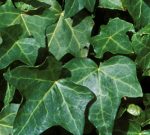
English ivy is an evergreen climbing vine and a member of the Aralia family, Araliaceae, that also includes Fatsia and Schefflera . It is native to most of Europe and western Asia where it grows in waste spaces and on walls and tree trunks. Introduced to America by early settlers as an ornamental, it has become invasive from New York and Michigan, south to Florida and Texas, and in the Pacific northwest, south through California. Although attractive to wildlife, this fast growing vine can damage stucco, wood or brick mortar and suffocate native vegetation. It prefers shade and moist soil with a pH of 6.5, but tolerates many kinds of soil except wet. USDA Hardiness Zones 6 and warmer.
Description: Growing up to 98’ long, this vine produces aerial rootlets with matted pads that cling tightly to various surfaces. The dark green leaves are waxy and have conspicuous white veins. Young leaves are palmately five-lobed while older leaves on flowering stems in full sun are unlobed and cordate. The small greenish-yellow flowers are produced in umbels up to 2” wide from late summer to late fall and are followed by .3” wide black-purple fruits attractive to wildlife.
Control: Vines should be cut or sawed as close the ground as possible and the upper parts of the vine pulled from the object it is climbing. This is best done in the hottest and driest time of year so any parts of the vine that remain die quickly. The roots are long and shallow and can easily be pulled from the soil after a rainfall when the soil is soft and workable especially in the spring before desirable perennials emerge. Wear a long sleeved shirt and gloves when working with the ivy to avoid irritants in the sap of the vine. In extreme cases, herbicides such as glyphosate or triclopyr can be used. Herbicide treatment is most effective when done in the spring but care must be taken to avoid contact with desirable species or beneficial insects. A combination of cutting the ivy and then using an herbicide is more effective than either alone but repeated treatments are probably necessary.